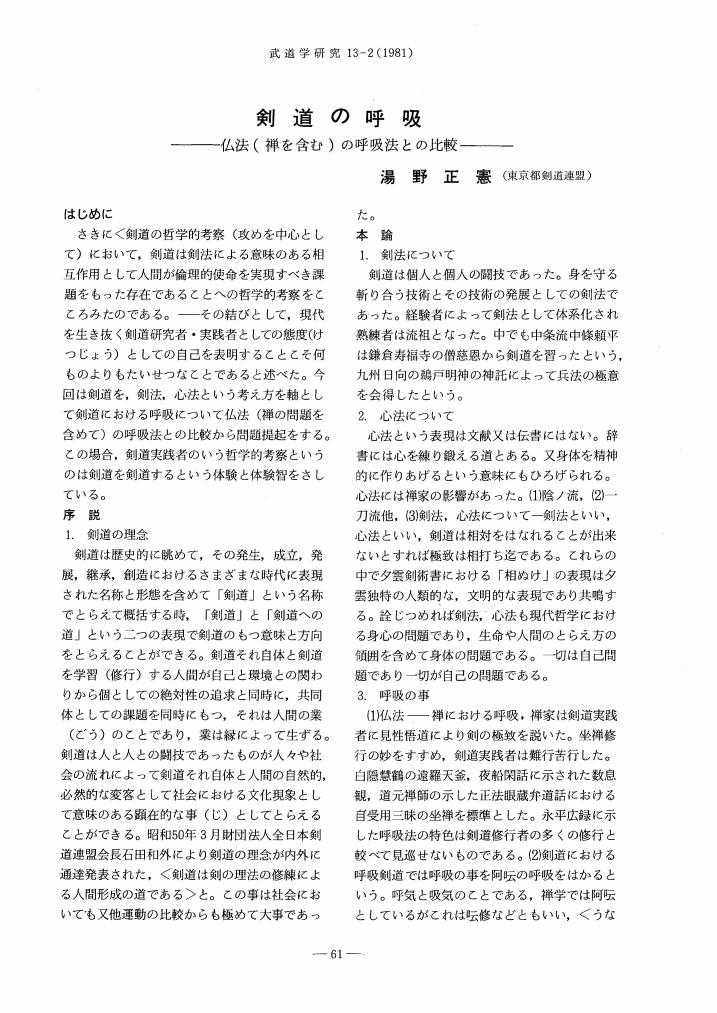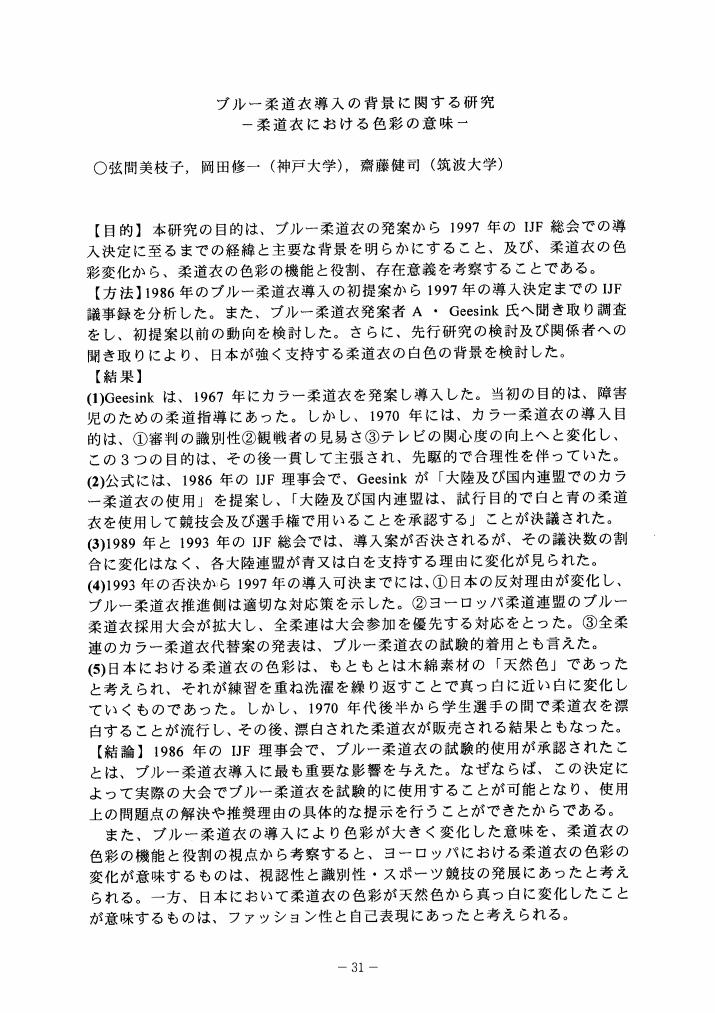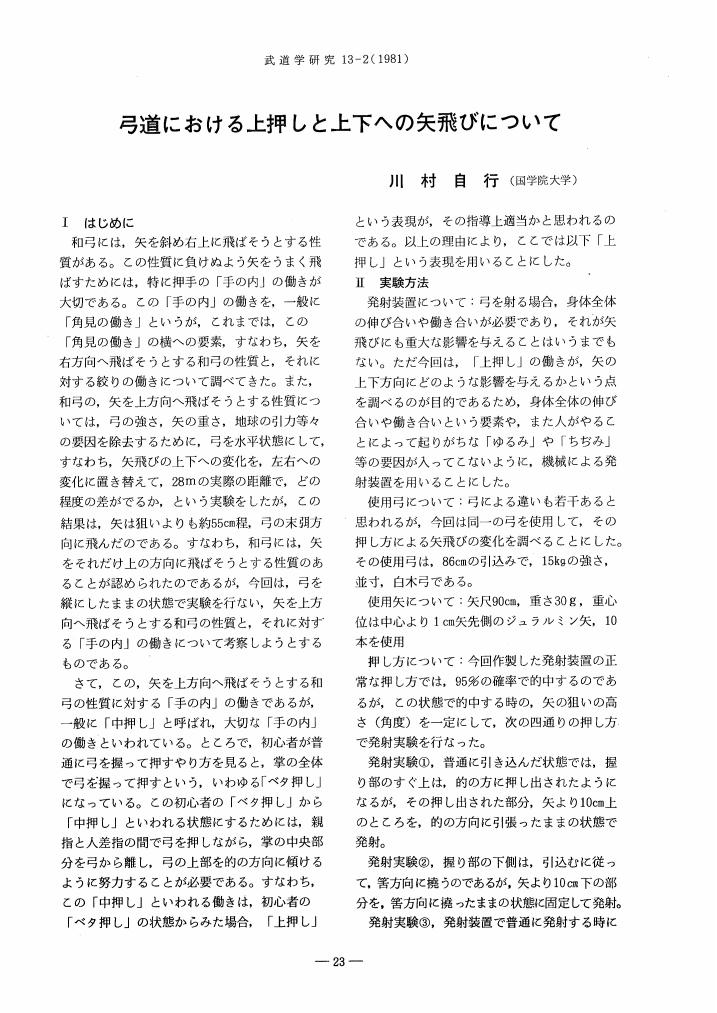1 0 0 0 剣道における打撃音と踏み込み音およびそれらの複合音の相違
- 著者
- 下川 美佳 金高 宏文 竹中 健太郎 赤崎 房生 前田 明
- 出版者
- 日本武道学会
- 雑誌
- 武道学研究 (ISSN:02879700)
- 巻号頁・発行日
- vol.51, no.1, pp.35-43, 2018
<p>本研究は,剣道の打撃動作にともなって発生する打撃音と踏み込み音との関係を明らかにすることを目的とした。そのために,ヒトの音に対する可聴範囲(20Hzから20000Hzまでの周波数帯域)内の200Hzから4900Hzを対象に打撃音,踏み込み音およびそれらの複合音(打撃音+踏み込み音)との相違について検討した。</p><p>その結果以下のことが明らかとなった。</p><p>(1)打撃音は踏み込み音や複合音より小音である。</p><p>(2)打撃音と踏み込み音および複合音では構成する周波数帯の振幅スペクトルが異なる。</p><p>(3)複合音は,ヒトの聞き取りやすい周波数帯の振幅スペクトル量を大きくする。</p>
1 0 0 0 OA 「剣道における試合内容分析」―第45回全日本剣道選手権大会を対象として―
- 著者
- 中村 充 菅波 盛雄 廣瀬 伸良
- 出版者
- 日本武道学会
- 雑誌
- 武道学研究 (ISSN:02879700)
- 巻号頁・発行日
- vol.31, no.3, pp.26-34, 1999-05-31 (Released:2012-11-27)
- 参考文献数
- 27
The purpose of this research is to do the detailed game analysis of the 45th all-Japan kendo championship.As the method, we made a new program, to collect information by using a personal computer and video. We collected the movement of the contents and player of all the techniques in the games as data by utilizing this system. And we analyzed the trend and present condition of the convention.We got the following result by this research.1. Such time when gets IPPON was long more before.2. Way of attacking which used the movement of the straight line furthermore and make the movement of small of a/the bamboo sword in, the present game is effective.3. The trend that attacks by the shock action like that and strike KOTE, this research was observed.4. The result that does and watch important that many players defend the shock of a partner even from that responds was seen.5. The game analysis program that we made was effective to do data input in detail and quickly. And, we think that we are effective in the comparison of the data and convention in terms of contestants.
1 0 0 0 アメリカ人柔道実践者の人格特性に関する研究
- 著者
- Matsumoto David 金野 潤 Ha Hyoung Zoo
- 出版者
- 日本武道学会
- 雑誌
- 武道学研究 (ISSN:02879700)
- 巻号頁・発行日
- vol.39, no.2, pp.17-26, 2006
柔道に関してよく掲げあげられている信念のひとつに、柔道は人格形成に寄与するというものがあるが、実際にそれを実証する学術的文献は今のところ存在しない。本研究はこのような先行研究の不足を補うため、柔道の実践が、自己統制、情動制御、誠実、勇敢、規律、敬意などにわたる人格特性と関連するかを検証した。アメリカ人柔道実践者、約160名を対象に、これらの人格特性、ならびに柔道実践の程度を測定する質問紙調査を実施した。柔道の実践とこれらの人格特性には正の相関が示された。年齢の影響を統計上取り除いたうえでも同様の結果が得られた。本研究は、これら特定の人格特性における柔道の効果をはじめて示唆する研究結果を報告したものである。
1 0 0 0 OA 武道,特に剣道練習後に見られる血色素尿について
- 著者
- 北村 李軒
- 出版者
- 日本武道学会
- 雑誌
- 武道学研究 (ISSN:02879700)
- 巻号頁・発行日
- vol.10, no.3, pp.21-27, 1978-03-05 (Released:2012-11-27)
- 参考文献数
- 24
In order to detect cases of Exertional Hemoglobinuria among Japanese Martial Art trainees, urine specimens obtained from 114 student members of Martial Art clubs (Kendo, Judo, Karate and Aikido) were examined.Exertional Hemoglobinuria was found in 15 out of 60 Kendo trainees and 3 out of 16 Aikido trainees respectively.Among these 18 cases of hemoglobinuria, however, only 3 cases presented macroskopic hematuria and the remaining 15 showed normal coloured urine.Thus, it must be emphasized that in Japan Martial Art training, especially Kendo exersise, is one of the main precipitating factors of Exertional Hemoglobinuria, and that there are often latent forms of the disease in which gross hematuria is not present.In considering the hemolytic mechanism occurring in Kendo exercise, I assume that the special action called “Fumikomi” operates as a mechanical trauma on the soles of the feet, although there must be other unknown factors for the development of this condition.
1 0 0 0 OA なぎなた競技における発現打突について
1 0 0 0 OA 剣道の呼吸
- 著者
- 湯野 正憲
- 出版者
- 日本武道学会
- 雑誌
- 武道学研究 (ISSN:02879700)
- 巻号頁・発行日
- vol.13, no.2, pp.61-62, 1981-03-10 (Released:2012-11-27)
1 0 0 0 國士館専門学校における武道教員養成の研究
- 著者
- 佐藤 宏拓穣
- 出版者
- 日本武道学会
- 雑誌
- 武道学研究 (ISSN:02879700)
- 巻号頁・発行日
- vol.39, no.2, pp.27-37, 2006
本研究は,昭和前半期における武道教員養成の実態を,國士館専門学校の場合を明らかにする。昭和前半期における武道教員の養成は,文部省に認可されていた東京高等師範学校(以下,高師と略記する),大日本武徳会武道専門学校(以下,武専と略記する),そして國士館の3校が行っていた。國士館は,昭和4(1929)年,文部省により専門学校として設置が認可された。昭和8(1933)年,剣道・柔道に対して文部省は,中等学校教員資格の免許を無試験で与えられることになった。
1 0 0 0 OA 近世初期における刀剣観に関する一考察
- 著者
- 酒井 利信
- 出版者
- 日本武道学会
- 雑誌
- 武道学研究 (ISSN:02879700)
- 巻号頁・発行日
- vol.24, no.3, pp.26-34, 1992-03-31 (Released:2012-11-27)
- 参考文献数
- 28
In the Middle ages, Kenjutsu schools were formed by a man of genius who played an active part in the Warring States period. And with this formation, a view of swords that involved skills was formed. This did not exist before the Middle ages.The purpose of this study is to clarify a view of swords in the 16th and 17th centuries. In order to clarify this whole structure, I analyzed the structure that symbolized swords.The results can be summarized as follows.1. As time passed, symbolic swords became abstract, but the object of representation became concrete.2. A view of swords in this time can be divided into three classes, those are that of a subconscious awareness, that of common understanding, and that of real activities. The feature of this time is the class of real activities, that is, a view of swords that involved skills. This structure also has relation to mindcontrol.
1 0 0 0 OA 体格差が勝敗に及ぼす影響について(1)―全日本柔道選手権大会過去10年間の試合結果から―
1 0 0 0 竹内流の成立過程に見る流派成立の条件について
- 著者
- 藤堂 良明 新出 隆
- 出版者
- 日本武道学会
- 雑誌
- 武道学研究 (ISSN:02879700)
- 巻号頁・発行日
- vol.29, no.1, pp.1-7, 1996-07
1 0 0 0 OA 「リズムなぎなた」の発祥から伝播・発展に関する研究
- 著者
- 福田 啓子
- 出版者
- 日本武道学会
- 雑誌
- 武道学研究 (ISSN:02879700)
- 巻号頁・発行日
- vol.46, no.1, pp.31-40, 2013-09-30 (Released:2014-09-30)
- 参考文献数
- 30
Naginata made a fresh start as a sport after World War II and in its new form, “Rhythm Naginata”, in which practitioners perform to rhythm such as music, was created. This study examines the process in which Rhythm Naginata was created and developed and the main instigators, and explores possibilities in the future development of Naginata as a field which demonstrates the diversity of budo arts. The budo arts were originally developed for combat. In post-war Naginata, however, Rhythm Naginata came to be utilised in the training and acquisition of basic moves and techniques such as forms of etiquette through the traditional process of learning Kata. This is because modern budo arts aim for character building, and are practiced by people as popular forms of traditional physical exercise. In tracing the origins of Rhythm Naginata, we find that “Naginata-Mai” (dance) was performed in Shinto rituals throughout Japan for invoking rain or abundant crops. Naginata-Mai, which was an elegant system of exercise considered suitable for girls, was created by Ozawa Unosuke. He was an educator who invented bujutsu-taisō (martial art calisthenics) in the latter years of the Meiji era when Naginata had yet to be approved as an authorized field of study in the education system. In the post-war era, Rhythm Naginata was initiated by Sonobe Shigehachi, headmaster of Jikishinkage-ryū. It is clearly stated in a bulletin published in 1966 that he coined the term “Rhythm Naginata”. Sonobe’s successors, Yamamoto Misao and Kajiyama Takeko, demonstrated Rhythm Naginata accompanied by piano for the first time as a public display at the 10th National Athletic Meet. In 1961, Mori Kiyoko, a teacher at Asaka Junior High School in Saitama Prefecture, created Rhythm Naginata for junior high school students, and demonstrated it at a Naginata meet. Yano Tsune, who studied the Tendō-ryū Naginata as one of the first generation of students in the Butokukai’s Naginata course, led the performance of Rhythm Naginata by students from Osaka University of Health and Sport Sciences at the Kobe Universiade in 1985. It was accompanied by traditional Japanese music and mainly displayed techniques from classical Naginata. Rhythm Naginata successfully achieved two outcomes: 1) it could be utilised as an effective educational medium; and 2) as a representation of Naginata’s cultural value it contributed to the spread and development of Naginata by showcasing its aesthetically pleasing movements and skills required in using a long weapon. Further study is needed to ascertain the connection between Naginata Mai and Rhythm Naginata.
1 0 0 0 OA 松平定信の武芸思想に関する一考察―新甲乙流への道程―
- 著者
- 菊本 智之
- 出版者
- 日本武道学会
- 雑誌
- 武道学研究 (ISSN:02879700)
- 巻号頁・発行日
- vol.23, no.3, pp.10-22, 1991-03-30 (Released:2012-11-27)
- 参考文献数
- 42
Kansei period in Edo era is a kind of time to change for Martial Arts. Sadanobu MATSUDAIRA played an active part mainly in this period as a political leader of the Shogunate or a master of Martial Arts. So, in studying Martial Arts after this period, it is the starting point to clarify his thought of Martial Arts.In this study, I paied attention to the points that he united KITO-RYU-JUDO and KOUOTSU-RYU, and that he made new KOUOTSU-RYU. Summaries were as follows.1. Sadanobu MATSUDAIRA devoted himself to Seibei SUZUKI's KITO-RYU-JUDO “SHINBU-NOMICHI”It was improved as “michi” which transcended “jutsu” and ruled the world.2. KOUOTSU-RYU was formed by the founder of “han”. Sadanobu MATSUDAIRA was under the influence of SHINKAGE-YAGYU-RYU and Takuan. So, it was the method to rule the world like SHINKAGE-YAGYU-RYU. Sadanobu MATSUDAIRA revived KOUOTSU-RYU that had formed by Sadatsuna MATSUDAIRA.3. Sadanobu MATSUDAIRA formed new KOUOTSU-RYU by uniting common points among KITORYU-JUDO “SHINBU-NO-MICHI” and KOUOTSU-RYU. New KOUOTSU-RYU was Martial Arts that assumed actual fighting. Because it needed to master practical skill of Matial Arts in order to realize the method to rule the world. This was his ideal, and it is concluded that it affected Martial Arts that was changed after Kansei period.
1 0 0 0 OA 嘉納治五郎の柔道観の力点と構造~言説分析によるアプローチから~
- 著者
- 永木 耕介
- 出版者
- 日本武道学会
- 雑誌
- 武道学研究 (ISSN:02879700)
- 巻号頁・発行日
- vol.32, no.1, pp.42-69, 1999 (Released:2012-11-27)
- 参考文献数
- 108
Jigoro Kano established Judo in 1882 and until his death in 1938 he promulgated the values of Judo through his many essays and texts. The purpose of this study was to clarify the emphasis and structure of values in Judo by Kano through an analysis of these texts.The research method undertaken was to set 8 main categories into which all the values espoused in Kano's work could be divided these being: (1) Moral, (2) Intellectual,(3) Physical,(4) Technique, (5)Martial art, (6)Seiryku-zenyou,(7) Jita-Kyouei (8) Cultural identity. The contents of his essays can be broken down and allocated to one or more of these categories. The emphasis and structure of values seen in Judo by Kano can be thought of as the sum each of these categories.The following results were revealed as summarized.1. The value of “Moral training” was seen most often, therefore, it was thought that Kano emphasised it as the most important value in fostering superior personalities through Judo training. Even though Ju-jitsu as a traditional martial art had valued “Moral training” only for Samurai class, Kano realised it's value for the general public.2. The “Physical” value of training the body was also strongly emphasized. It was well-known that Kano appreciated this value from the view points of being strong and well-balanced body, and the useful for ordinary life.3. In the technical aspect of Judo, Kano valued the principle of beating opponents by using their strength which was original in the period of Meiji era. The practice of techniques was classified into Kata (via prearranged orders and methods) and Randori (free practice), Ranori was valued for making strong body and spirit, and Kata was for physical fitness for general. Kano rationalised Judo techniques through a compare with other Western sports and gymnastics.4. Kano also valued Judo as a type of strong marital art. He realised the value of “self-defense”. Therefor, he emphasized throwing techniques in Randori and striking techniques in Kata. He also emphasized a serious attitude in practising as seen though the view point of traditional “Shugyou”thought. The reason for this was to foster superior personality through the experience of high spiritual tension.5. “Seiryoku-zenyou” and “Jita-Kyouei” became the philosophy of Judo from the Taisho era. “Seiryokuzenyou” meant the most effective use of one's spiritual and physical strength and “Jita-Kyouei”meant revolving around harmonious relationships between oneself and others. Kano seemed to emphasis “Seiryoku-zenyou” rather than “Jita-Kyouei” in a Judo context, because “Seiryoku-zenyou”was more closely related to Judo practice.6. Kano valued Judo as a from of Japanese “Cultural identity” during the time of Meiji era. After the Taisho era., he saw the value in developing Judo in order to internationalized culture.
1 0 0 0 OA ブルー柔道衣導入の背景に関する研究
1 0 0 0 OA 弓射に及ぼす催眠暗示の影響
- 著者
- 根木 哲郎 杉江 正敏 荻原 郡次
- 出版者
- 日本武道学会
- 雑誌
- 武道学研究 (ISSN:02879700)
- 巻号頁・発行日
- vol.10, no.1, pp.19-24, 1977-07-05 (Released:2012-11-27)
- 参考文献数
- 21
We lead the subjects into hypnotic state and by giving verbal suggestion how to learn and let them in calm state and then, inspected how the experiment influenced to the technic during shuting archery.First, the verbal suggestion was given to subjecs to lead them in the state of mental concentration. By means of this suggestion, the subjects became free from all ideas and thought and this brought increment of concentration and more over, the best condition to take EMG.Secondly, we inspected how the suggestion that the subject felt target situated very near just at the point of arrow effected the result.ResultMuscle activity decreased and showed steady patern. This means smoothness of muscle activity. It looks like the trained group.The average rate of hits in normal state was 48.8% and hypnotic state 62.4%.This was 14% increment. (P<0.025)
1 0 0 0 OA 中国武術の型(表演)試合における審判方法の問題点
- 著者
- 七堂 利幸 朝倉 宏之 藤田 誠
- 出版者
- 日本武道学会
- 雑誌
- 武道学研究 (ISSN:02879700)
- 巻号頁・発行日
- vol.22, no.3, pp.57-64, 1990-03-31 (Released:2012-11-27)
- 参考文献数
- 6
After examining the judging procedures relating to Chinese martial arts demonstrations it has become clear that using the score of the first person as a standard for judging the other participants produces an obvious upward trend in scoring, meaning that the later a person performs the better his or her score is likely to be, and therefore this cannot be considered an acceptable method of scoring. Furthermore, there is no standard for scoring for the larger part of the events; and for some, even if there are standards they are ignored in practice and the afore-said method of scoring is used. As to why there should be an upward trend in scoring, perhaps the judges feel reluctant to give out very high scores at first for fear that a truly exceptional participant will appear later. Therefore, one's order of appearance has a profound effect on one's score, and there is no proper discrimination in scoring. Regarding the reliability of scoring, there is also a problem with large discrepancies in scoring between preliminary and final rounds. The following standardized set of procedures should be adopted: Practitioners of one form should compete in one event, Events without set standards for scoring should be established and judged by persons specializing in that event. Ttraining and checking of judges should be implemented. The number of persons advancing to the finals should be determined by the number of people in the preliminaries. Scoring should be conducted independently and individually. And, most of all, the order of appearance of participants should be decided fairly and impartially. If these things are not done it will probably be impossible to establish this as a competition.
1 0 0 0 内股に関するバイオメカニクス的研究
1 0 0 0 OA 弓道での傷害群と非傷害群における体幹機能の違い
1 0 0 0 OA 弓道における上押しと上下への矢飛びについて
- 著者
- 川村 自行
- 出版者
- 日本武道学会
- 雑誌
- 武道学研究 (ISSN:02879700)
- 巻号頁・発行日
- vol.13, no.2, pp.23-24, 1981-03-10 (Released:2012-11-27)






